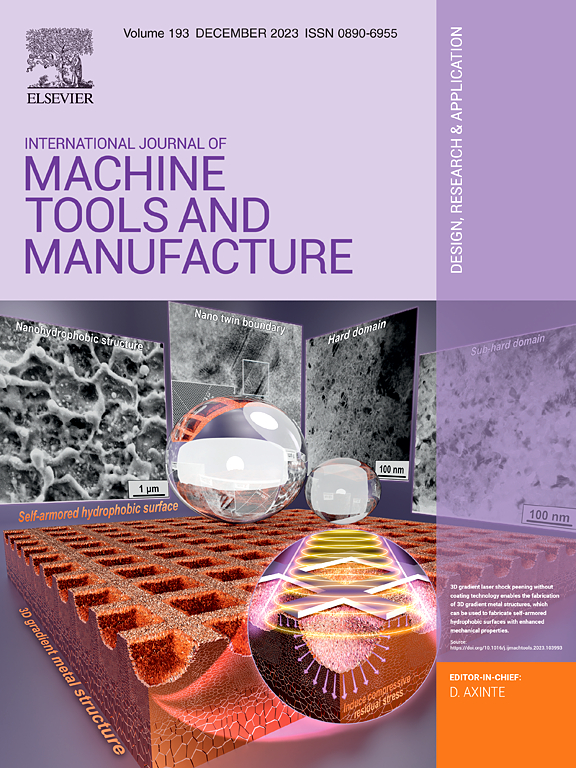一种增强微复杂镁合金零件增材制造的抑制蒸发新方法
IF 18.8
1区 工程技术
Q1 ENGINEERING, MANUFACTURING
International Journal of Machine Tools & Manufacture
Pub Date : 2025-05-01
DOI:10.1016/j.ijmachtools.2025.104281
引用次数: 0
摘要
对微复杂和可定制镁合金结构的需求不断增长,给增材制造(AM)带来了重大挑战,特别是在控制孔隙率和实现高尺寸精度方面。这些挑战来自气泡夹持和剧烈的Mg蒸发引起的爆炸事件。这项研究首次阐明了这些缺陷的基本机制,确定了熔池内自发气泡成核和随后的爆炸是根本原因。在基于金属液滴的增材制造(MDBM)中,实验表明,由于能量释放加剧,较大的气泡使液滴不稳定,并破坏沉积轨迹,最终降低打印质量。为了解决这一问题,开发了一个独立于特定镁合金增材制造方法的气泡成核和生长模型。在此基础上,提出了一种减轻Mg蒸发缺陷的新策略。通过确定临界气泡成核温度,确定在此阈值以下操作完全抑制气泡成核,从而防止相关缺陷。对于超过该温度的条件,气泡生长模型可以通过工艺参数优化精确调节气泡尺寸,有效地减少缺陷,提高结构完整性。结果表明,制备的结构具有较高的尺寸精度和优异的力学性能,具有无孔微结构,尺寸偏差最小,力学性能增强的特点。本研究介绍了一种参数驱动的方法,用于抑制各种镁合金增材制造技术中Mg蒸发引起的缺陷,该方法可能适用于其他高蒸发金属增材制造工艺。此外,它代表了首次使用高蒸发性金属成功制造微型复杂结构,扩大了MDBM的材料选择。本文章由计算机程序翻译,如有差异,请以英文原文为准。

A novel suppressing evaporation method for enhancing micro-complex magnesium alloy parts additive manufacturing
The increasing demand for micro-complex and customizable magnesium (Mg) alloy structures presents significant challenges for additive manufacturing (AM), particularly in controlling porosity and achieving high-dimensional accuracy. These challenges arise from bubble entrapment and explosive events caused by intense Mg evaporation. This study, for the first time, elucidates the fundamental mechanism underlying these defects, identifying spontaneous bubble nucleation and subsequent explosions within the melt pool as the root cause. In metal droplet-based AM (MDBM), experiments demonstrate that larger bubbles destabilize droplets and disrupt deposition trajectories due to intensified energy release, ultimately degrading print quality. To address this issue, a bubble nucleation and growth model, independent of specific Mg alloy AM methods, was developed. Based on this model, a novel strategy was proposed to mitigate Mg evaporation-induced defects. By identifying a critical bubble nucleation temperature, it was established that operating below this threshold completely suppresses bubble nucleation, thereby preventing associated defects. For conditions exceeding this temperature, the bubble growth model enables precise regulation of bubble size through process parameter optimization, effectively minimizing defects and enhancing structural integrity. As a result, the fabricated structures exhibit high dimensional precision and superior mechanical performance, characterized by pore-free microstructures, minimal dimensional deviation, and enhanced mechanical properties. This study introduces a parameter-driven method for suppressing Mg evaporation-induced defects across various Mg alloy AM technologies, with potential applicability to other highly evaporative metal AM processes. Moreover, it represents the first successful fabrication of micro-complex structures using highly evaporative metals, expanding the material selection for MDBM.
求助全文
通过发布文献求助,成功后即可免费获取论文全文。
去求助
来源期刊
CiteScore
25.70
自引率
10.00%
发文量
66
审稿时长
18 days
期刊介绍:
The International Journal of Machine Tools and Manufacture is dedicated to advancing scientific comprehension of the fundamental mechanics involved in processes and machines utilized in the manufacturing of engineering components. While the primary focus is on metals, the journal also explores applications in composites, ceramics, and other structural or functional materials. The coverage includes a diverse range of topics:
- Essential mechanics of processes involving material removal, accretion, and deformation, encompassing solid, semi-solid, or particulate forms.
- Significant scientific advancements in existing or new processes and machines.
- In-depth characterization of workpiece materials (structure/surfaces) through advanced techniques (e.g., SEM, EDS, TEM, EBSD, AES, Raman spectroscopy) to unveil new phenomenological aspects governing manufacturing processes.
- Tool design, utilization, and comprehensive studies of failure mechanisms.
- Innovative concepts of machine tools, fixtures, and tool holders supported by modeling and demonstrations relevant to manufacturing processes within the journal's scope.
- Novel scientific contributions exploring interactions between the machine tool, control system, software design, and processes.
- Studies elucidating specific mechanisms governing niche processes (e.g., ultra-high precision, nano/atomic level manufacturing with either mechanical or non-mechanical "tools").
- Innovative approaches, underpinned by thorough scientific analysis, addressing emerging or breakthrough processes (e.g., bio-inspired manufacturing) and/or applications (e.g., ultra-high precision optics).

 求助内容:
求助内容: 应助结果提醒方式:
应助结果提醒方式:


